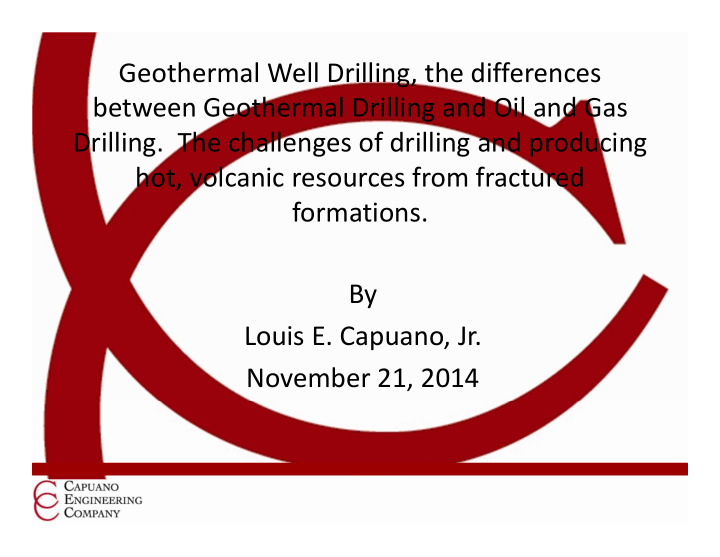



Geothermal Well Drilling, the differences between Geothermal Drilling and Oil and Gas Drilling. The challenges of drilling and producing hot, volcanic resources from fractured formations. By Louis E. Capuano, Jr. November 21, 2014
Different types of Geothermal Resources Resource Type • Liquid ‐ dominated. • Vapor ‐ dominated • Geopressured ‐ Geothermal • Engineered Geothermal System (EGS)
Field and Lithology Information
Differences between Oil/Gas and Geothermal Drilling • Temperature • Hard ‐ Rock Formations • Large Wellbore • Low Reservoir Pressure • Completion Methods
Temperature • Normal Geothermal Gradient is 1 ˚ to 1.5 ˚ per 100’. Geothermal Gradient can be as high as 10 ˚ per 100’ • Reservoir Temperatures can be as low as 280 ˚ to 300 ˚ F to as high as 700 ˚ F plus. • Changes will have to be made to all conventional drilling tools, materials and equipment to withstand temperature in the Reservoir.
Temperature • Mud coolers • High temperature electronics • High temperature cements • High temperature mud additives
Mud Coolers • Needed to keep fluid cool to maintain mud properties. – Wall Cake – Gel Yield – Carrying Capacity • High Temperatures can damage electronic drilling tools. • Mud must be changed out prior to entering the productive reservoir.
High Temperature Electronics • Directional tools are very temperature sensitive • Wireline electronic logging tools are also very temperature sensitive • Bit program design must take temperature and circulating media into consideration
High Temperature Cement and Cementing Procedures Cements will need to be • retarded to withstand reservoir conditions. Unlike Oil and Gas wells, • casing in Geothermal wells need to be cemented across entire length. Uncemented voids in casing • annuli will result in casing failures (One of the primary important factor of a good geothermal well is a good cement job on all casing strings).
High Temperature Mud Additives • Gel (Bentonite) Muds can cause formation damage in production sections. • High temperature polymers are needed to clean the hole and stabilize the wellbore. • Air or Aerated Fluids can be used due to low pressure formations. • Air / Aerated Drilling can cause hole integrity problems.
Hard Rock Formation Volcanic hard rock may exist from spud to total depth. • Permeability exists primarily in fracture systems. • Fractures may exist throughout the entire wellbore. • Lost Circulation due to fractures and low reservoir pressures is very • common. PDC bits do not perform well due to air/aerated drilling, fractures and • increased temperatures. Lost circulation zones make casing cementing difficult •
Large Diameter Well Completions • Production rates are directly proportional to the diameter of the well • Large diameter “hard ‐ rock” bits are expensive and drill slow due to available weight on bit. • Large diameter casing and hole sizes require large amounts of cement and the placement methods become critical
Low Reservoir Pressures • High potential of loss circulation in drilling and cementing. • Low pressure may require the wells to be pumped requiring large diameter down ‐ hole pumps, therefore large diameter wells. • Drilling media, mud, air or aerated water or mist must be used to penetrate reservoir
Completion Methods • Many geothermal wells are completed open hole and resource is produced through casing. • Slotted or Perforated casing is utilized to filter large formation debris from entering flow stream. • Wellhead completion are large diameter master valve through which the well was drilled
Major problems in Drilling Geothermal Wells • Temperature • Hard ‐ Rock Formations • Large Wellbore • Low Reservoir Pressures • Completion Methods
Recommend
More recommend